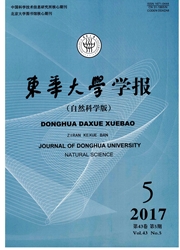

 中文摘要:
中文摘要:
基于纤维集合体的结构特征和纤维对光的反射、散射和吸收特性,前期已推导出由透光信号计算纤维集合体的光学面密度新算法,被称为Wu-Wang算法或W-W算法.利用此算法由试样各点的透光强度计算纤维堆砌的面密度,进而获取随机须丛的线密度曲线,即须丛曲线.5种羊毛条子的试验结果证明:基于此算法获取的须丛曲线与单根长度测量法、Almeter法测得数据换算的须丛曲线非常一致,可进一步精确测量羊毛和其他纤维的长度分布;由于手工制样和纤维条的随机波动,目前随机须丛的随机波动明显,一种毛条试样需要测量5个不同横截面的须丛,5个须丛的平均须丛曲线非常稳定;与单根长度测量法、Almeter法的测量结果对比,发现随机须丛中纤维的伸直度偏低,需对须丛曲线进行卷曲修正.
 英文摘要:
英文摘要:
Considering the reflection, scattering and the absorption effects of the fiber assemblies, an algorithm named Wu-Wang algorithm or W-W algorithm is derived in former study for calculating the fiber assemblies' relative density from the transmittance information. The fiber density of every unit in the image is calculated by this algorithm from the transmittance for the linear density curve of the random beard, which is called the fibrogram. The findings from the experiment results of 5 lots wool fibers are as follows. The fibrograms measured by the random beard image method showed high consistent with that by the single-fiber method and the Almeter 100, that is to say this algorithm can be used to calculate the length distributions of the wool fiber and other fibers. The random waves of the fiber length distribution of any cross-section in the random beard are obvious, while the average fibrogram of 5 different cross-section is stable. Compared with the single-fiber method and the Almeter, the fiber straightness in the random beard is low, which calls for a crimp modification for the fibrogram.
 同期刊论文项目
同期刊论文项目
 同项目期刊论文
同项目期刊论文
 期刊信息
期刊信息
